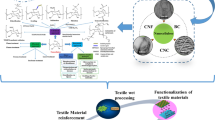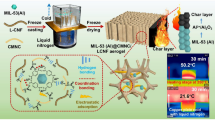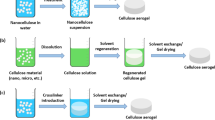Abstract
Cladophora, a fresh-water green macroalgae, has unique cellulose properties and thus may be promising for production of cellulose nanofibrils (CNFs). Cellulose was extracted from Cladophora glomerata and subjected to microfluidization with or without enzymatic hydrolysis pretreatment to produce CNFs. Increasing microfluidization passes produced smaller algal CNFs with more uniform sizes and lower crystallinity. Combining microfluidization with an enzymatic hydrolysis pretreatment, the algal CNFs’ crystallinity decreased further, but the diameter distribution showed little change. The algal CNFs were compared to CNFs produced from bleached eucalyptus pulp (BEP), with the algal CNFs having significantly higher crystallinity, smaller diameter and better thermal stability. The XRD spectra of algal and BEP CNFs were simulated by Mercury 3.0 software. The results indicated that BEP CNFs are mainly cellulose Iβ with a random orientation, while algal CNFs are likely a hybrid of cellulose Iα with preferred orientations along the [100] and [010] axes with a March–Dollase factor of 0.65.









Similar content being viewed by others
Abbreviations
- BEP:
-
Bleached eucalyptus pulp
- CI:
-
Crystallinity index
- CNFs:
-
Cellulose nanofibrils
- alg-CNF-10 and alg-CNF-20:
-
Algal CNFs produced by microfluidization only with 10 or 20 passes
- alg-CNF-enzy and BEP-CNF-enzy:
-
Algal CNFs or BEP CNFs produced by enzymatic hydrolysis and microfluidization with 20 passes
- FWHM:
-
Full width at half maximum
References
Alemdar A, Sain M (2008) Isolation and characterization of nanofibers from agricultural residues—wheat straw and soy hulls. Bioresour Technol 99:1664–1671
Auer MT, Tomlinson LM, Higgins SN, Malkin SY, Howell ET, Bootsma HA (2010) Great Lakes Cladophora in the 21st century: same algae-different ecosystem. J Great Lakes Res 36:248–255
Camacho DH, Gerongay SRC, Macalinao JPC (2013) Cladophora cellulose-polyaniline composite for remediation of toxic chromium (VI). Cell Chem Technol 47:125–132
French AD (2014) Idealized powder diffraction patterns for cellulose polymorphs. Cellulose 21:885–896
French AD, Santiago Cintrón M (2013) Cellulose polymorphy, crystallite size, and the segal crystallinity index. Cellulose 20:583–588
Henriksson M, Henriksson G, Berglund LA, Lindstrom T (2007) An environmentally friendly method for enzyme-assisted preparation of microfibrillated cellulose (MFC) nanofibers. Eur Polym J 43:3434–3441
Hoeger IC, Nair SS, Ragauskas AJ, Deng Y, Rojas OJ, Zhu JY (2013) Mechanical deconstruction of lignocellulose cell walls and their enzymatic saccharification. Cellulose 20:807–818
Hua K, Carlsson DO, Alander E, Lindstrom T, Stromme M, Mihranyan A, Ferraz N (2014) Translational study between structure and biological response of nanocellulose from wood and green algae. RSC Adv 4:2892–2903
Hult EL, Larsson PT, Iversen T (2001) Cellulose fibril aggregation—an inherent property of kraft pulps. Polymer 42:3309–3314
Imai T, Sugiyama J (1998) Nanodomains of Iα and Iβ cellulose in algal microfibrils. Macromolecules 31:6275–6279
Iwamoto S, Nakagaito AN, Yano H (2007) Nano-fibrillation of pulp fibers for the processing of transparent nanocomposites. Appl Phys A Mater 89:461–466
Jagadeesh D, Reddy DJP, Rajulu AV (2011) Preparation and properties of biodegradable films from wheat protein isolate. J Polym Environ 19:248–253
Koyama M, Sugiyama J, Itoh T (1997) Systematic survey on crystalline features of algal celluloses. Cellulose 4:147–160
Leppänen K, Andersson S, Torkkeli M, Knaapila M, Kotelnikova N, Serimaa R (2009) Structure of cellulose and microcrystalline cellulose from various wood species, cotton and flax studied by X-ray scattering. Cellulose 16:999–1015
Leu SY, Zhu JY (2013) Substrate-related factors affecting enzymatic saccharification of lignocelluloses: our recent understanding. Bioenerg Res 6:405–415
Macrae CF, Gruno IJ, Chisholm JA, Edgington PR, McCabe P, Pidcock E, Rodriguez-Monge L, Taylor R, van de Streek J, Wood PA (2008) Mercury CSD 2.0-new features for the visualization and investigation of crystal structures. J Appl Crystallogr 41:466–470
Mihranyan A (2011) Cellulose from Cladophorales green algae: from environmental problem to high-tech composite materials. J Appl Polym Sci 119:2449–2460
Mihranyan A, Andersson SB, Ek R (2004) Sorption of nicotine to cellulose powders. Eur J Pharm Sci 22:279–286
Moon RJ, Martini A, Nairn J, Simonsen J, Youngblood J (2011) Cellulose nanomaterials review: structure, properties and nanocomposites. Chem Soc Rev 40:3941–3994
Moran JI, Alvarez VA, Cyras VP, Vazquez A (2008) Extraction of cellulose and preparation of nanocellulose from sisal fibers. Cellulose 15:149–159
Mwaikambo LY, Ansell MP (2002) Chemical modification of hemp, sisal, jute, and kapok fibers by alkalization. J Appl Polym Sci 84:2222–2234
Nelson ML, O’Connor RT (1964) Relation of certain infrared bands to cellulose crystallinity and crystal lattice type. Part II. A new infrared ratio for estimation of crystallinity in celluloses I and II. J Appl Polym Sci 8:1325–1341
Nishiyama Y, Langan P, Chanzy H (2002) Crystal structure and hydrogen-bonding system in cellulose Iβ from synchrotron X-ray and neutron fiber diffraction. J Am Chem Soc 124:9074–9082
Nishiyama Y, Sugiyama J, Chanzy H, Langan P (2003) Crystal structure and hydrogen bonding system in cellulose Iα, from synchrotron X-ray and neutron fiber diffraction. J Am Chem Soc 125:14300–14306
Paakko M, Ankerfors M, Kosonen H, Nykanen A, Ahola S, Osterberg M, Ruokolainen J, Laine J, Larsson PT, Ikkala O, Lindstrom T (2007) Enzymatic hydrolysis combined with mechanical shearing and high-pressure homogenization for nanoscale cellulose fibrils and strong gels. Biomacromolecules 8:1934–1941
Qing Y, Sabo R, Zhu JY, Agarwal U, Cai Z, Wu Y (2013) A comparative study of cellulose nanofibrils disintegrated via multiple processing approaches. Carbohyd Polym 97:226–234
Reddy N, Yang Y (2005) Biofibers from agricultural byproducts for industrial applications. Trends Biotechnol 23:22–27
Segal L, Creely JJ, Martin AE, Conrad CM (1959) An empirical method for estimating the degree of crystallinity of native cellulose using the X-ray diffractometer. Text Res J 29:786–794
Siro I, Plackett D (2010) Microfibrillated cellulose and new nanocomposite materials: a review. Cellulose 17:459–494
Spence KL, Venditti RA, Rojas OJ, Habibi Y, Pawlak JJ (2011) A comparative study of energy consumption and physical properties of microfibrillated cellulose produced by different processing methods. Cellulose 18:1097–1111
Strømme M, Mihranyan A, Ek R (2002) What to do with all these algae? Mater Lett 57:569–572
Wang Q, Zhu JY (2015) Facile preparation of nanofiller-paper using mixed office paper without deinking. Tappi J 14:167–174
Wang QQ, Zhu JY, Gleisner R, Kuster TA, Baxa U, McNeil SE (2012) Morphological development of cellulose fibrils of a bleached eucalyptus pulp by mechanical fibrillation. Cellulose 19:1631–1643
Wang W, Mozuch MD, Sabo RC, Kersten P, Zhu JY, Jin Y (2015) Production of cellulose nanofibrils from bleached eucalyptus fibers by hyperthermophilic endoglucanase treatment and subsequent microfluidization. Cellulose 22:351–361
Yang H, Yan R, Chen H, Lee DH, Zheng C (2007) Characteristics of hemicellulose, cellulose and lignin pyrolysis. Fuel 86:1781–1788
Yue Y, Han J, Han G, Zhao Q, French AD, Wu Q (2015) Characterization of cellulose I/II hybrid fibers isolated from energycane bagasse during the delignification process: morphology, crystallinity and percentage estimation. Carbohyd Polym 133:438–447
Zhao H, Kwak JH, Zhang ZC, Brown HM, Arey BW, Holladay JE (2007) Studying cellulose fiber structure by SEM, XRD, NMR and acid hydrolysis. Carbohyd Polym 68:235–241
Zhu JY, Sabo R, Luo X (2011) Integrated production of nano-fibrillated cellulose and cellulosic biofuel (ethanol) by enzymatic fractionation of wood fibers. Green Chem 13:1339–1344
Acknowledgments
This work was supported by the National Natural Science Foundation of China (31400512) and US Department of Agriculture NIFA, under Critical Agricultural Material Grant (2013-38202-20400). The authors would like to give their appreciations to Dr. Alfred French for personal communications about the simulation of XRD patterns and to Dr. Renil Anthony for his assistance with algae collection.
Author information
Authors and Affiliations
Corresponding authors
Rights and permissions
About this article
Cite this article
Xiang, Z., Gao, W., Chen, L. et al. A comparison of cellulose nanofibrils produced from Cladophora glomerata algae and bleached eucalyptus pulp. Cellulose 23, 493–503 (2016). https://doi.org/10.1007/s10570-015-0840-7
Received:
Accepted:
Published:
Issue Date:
DOI: https://doi.org/10.1007/s10570-015-0840-7




